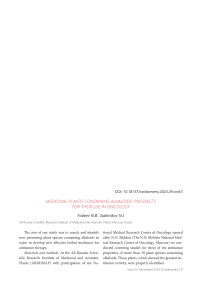Medicinal plants containing alkaloids: prospects for their use in oncology
Автор: Fadeev N.B., Sidelnikov N.I.
Журнал: Cardiometry @cardiometry
Рубрика: Conference proceedings
Статья в выпуске: 29, 2023 года.
Бесплатный доступ
The aim of our study was to search and identify new promising plant species containing alkaloids in order to develop new effective herbal medicines for antitumor therapy.
Alkaloid, plant bio-collection, apoptosis, herbal medicine
Короткий адрес: https://sciup.org/148327377
IDR: 148327377 | DOI: 10.18137/cardiometry.2023.29.conf.5
Текст статьи Medicinal plants containing alkaloids: prospects for their use in oncology
All-Russian Scientific Research Institute of Medicinal and Aromatic Plants, Moscow, Russia
The aim of our study was to search and identify new promising plant species containing alkaloids in order to develop new effective herbal medicines for antitumor therapy.
Materials and methods. At the All-Russian Scientific Research Institute of Medicinal and Aromatic Plants (ARSRIMAP) with participation of the Na- tional Medical Research Center of Oncology named after. N.N. Blokhin (The N.N. Blokhin National Medical Research Center of Oncology, Moscow) we conducted screening studies (in vitro) of the antitumor properties of more than 30 plant species containing alkaloids. Those plants, which showed the greatest antitumor activity, were properly identified.
Results . Studies have been carried out on extracts and individual compounds from a number of plants collected by the ARSRIMAP specialists in their field expeditions and obtained from the Institute’s own bio-collections. The biological diversity of alkaloid-bearing plants is wide and includes representatives of a number of families of higher plants (Amaryllidaceae, Fabaceae, Apiaceae, Papaveraceae, Nymphaceae, Berberidaceae, etc.). Among the most active, the following plants and alkaloids are noted: species of the genus aconite (A. Karakolsky - Aco-nitum karakolicum Rapaics, A. Baikalsky - A. bai-calense Turcz. ex Rapaics, family Ranunculaceae), alkaloid of the hemlock spotted (Conium macula-tum L., family. Apiaceae) - coniine, alkaloids of the bulbs of the magnificent crocus (Colchicum specio-sum Steven, family Melanthiaceae) - colchicine and colchamine, alkaloids from the roots of shrubby sophora (Sophora flavescens Aiton, family Fabaceae) -matrine and oxymatrine, the alkaloid galantamine from the bulbs of the Siberian sqill (Scilla siberica Haw., family Hyacinthaceae) and the Voronov’s snowdrop (Galanthus woronowii Losinsk. family Amaryllidaceae).
The ARSRIMAP researchers have shown the prospects for use in oncology of the alkaloid nuflein, isolated from the rhizomes with roots of yellow water-lily (Nuphar lutea (L.) Sm., family Nymphaeaceae), which shows a 200 times greater activity against human cervical cancer cells than the drug cisplatin.
In our experiments using xenografts of stomach cancer and human hepatocellular carcinoma transplanted into immunodeficient animals, the alkaloid sanguinarine, isolated from the herb of the plants of the genus Macleaya (Macleaya R.Br.) of the poppy family (Papaveraceae), caused a significant (3-5 times) inhibition of the tumor growth [ 1]. The safety of the substance used in therapeutic doses and the multiplicity of the mechanisms responsible for implementing its antitumor effect were also demonstrated. It can be assumed that the antitumor effect of the Macleaya alkaloids may be enhanced due to systemic effects based on their immunostimulating properties. The alkaloid sanguinarine has also been found to induce apoptosis of tumor cells through the release of nitric oxide (NO) and superoxide radicals in prostate cancer cells, in particular, apoptosis of lymphoma cells in the primary effusion, as well as dose-dependent apoptosis of A431 and NHEKs car- 12 | Cardiometry | Issue 29. November 2023
cinoma cells [2]. Sanguinarine and chelerythrine are the active substances of the drug “Sanguinarine”, developed by ARSRIMAP.
The antitumor drug “Vincristine”, developed by ARSRIMAP together with the National Medical Research Center of Oncology named after. N.N. Blokhin on the basis of the alkaloid from the herb Catha-ranthus roseus (L.) G. Don, family Apocynaceae, has found its international recognition and is included in the Russian National Registry of Vital Essential Medicines.
The alkaloid matrine, one of the main alkaloids isolated from the rhizomes of Sophora flavensis, suppresses significantly the tumor growth and induces apoptosis in vivo and in vitro of the murine hepato-carcinoma H 22 cells.
The experience in using alkaloid-containing plants in medicine by experts of the Phytotherapeutic Society (Moscow) and the St. Petersburg Society of Therapists named after. S.P. Botkin (section of herbal medicine) allows us to recommend the above plants with their antitumor and antiviral activity as an accompanying agent, significant for practical herbal medicine in oncology.
Conclusion . We have succeeded in demonstration of the prospects and the needs to expand investigations in the search for new plant species of the world flora containing alkaloids and other classes of biologically active natural compounds for the development of effective herbal medicines, which can be used in complex antitumor therapy both as direct inhibitors of the tumor growth and effective modulators of the immune system to promote the activation of the systemic and cellular mechanisms of the antitumor resistance by the body.
The above study was carried out within the framework of the State Assignment (Research work No. FGUU-2022-0014) using bio-objects of the Unique Scientific System “Biocollections of the Federal State Budgetary Institution ARSRIMAP”.
Список литературы Medicinal plants containing alkaloids: prospects for their use in oncology
- Fedotcheva TA, et al. Nuflein bisane hydrochloride, which has cytotoxic activity against human tumor cells. Patent for invention RU2624861C, 07/07/2017.
- Tolkachev O.N., Fateeva T.V., Krepkova L.V., Vichkanova S.A., Bortnikova V.V. Domestic and foreign drugs containing sanguinarine: brief assessment(review). Issues of biological, medical and pharmaceutical chemistry. 2015;9:3-9.


